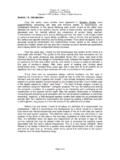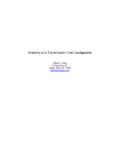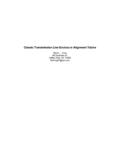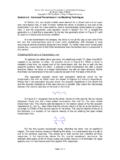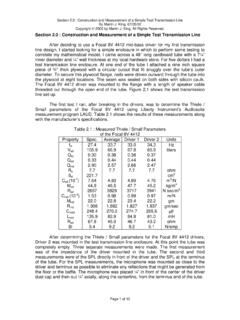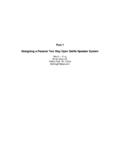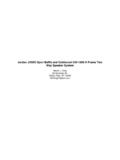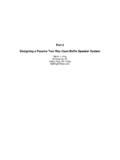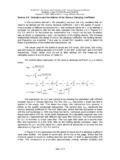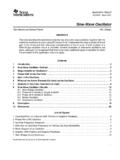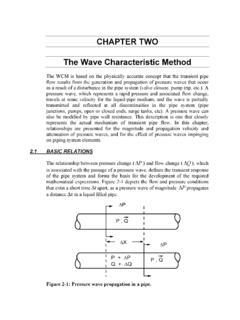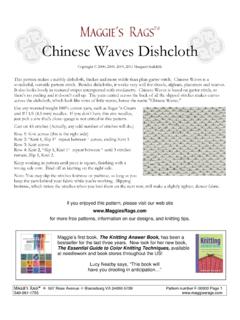Transcription of A Method for Designing a Compact Back Loaded …
1 A Method for Designing a Compact back Loaded Horn Loudspeaker System Martin J. King 40 Dorsman Dr. Clifton Park, NY 12065 A Method for Designing a Compact back Loaded Horn Loudspeaker System By Martin J. King, 06/20/12 (revised 09/03/12) Copyright 2012 by Martin J. King. All Rights Reserved. Page 1 of 15 Introduction : For the past 15+ years, I have been studying back Loaded horn enclosure designs for full range drivers. This involved reverse engineering almost every back Loaded horn design I have been able to find on the Internet. If a cross-section plot or picture is provided to scale internal dimensions, or even better detailed drawings are provided for other DIY builders to follow, then I have probably run a simulation to see how the design performs.
2 Of particular interest were fully documented designs that also included measured electrical impedance and SPL frequency response plots to correlate against my MathCad worksheet predictions. When actual test data was provided the simulations usually correlated well and I have learned a lot of modeling techniques through these exercises. In parallel with reverse engineering other people s designs, I have put a lot of effort into my own design studies with mixed results. It is not too hard to produce a paper design with a calculated response that looks really bad and not worth building.
3 Or if the calculated response looks promising the size of the resulting enclosure is huge, again not worth building. The number of designs analyzed and stored on my hard drive has to be over one hundred. After all these years of computer work, I am somewhat embarrassed to admit I have yet to build a back Loaded horn of any kind. I have not found a design that stands out analytically as a great performer in a reasonably sized enclosure worth the effort required to build it. This is clearly bordering on a textbook case of analysis paralysis. The biggest problem is achieving adequate bass response in a reasonably sized and simple enclosure design.
4 About three years ago, I started to overcome some of the problems I had been struggling with for all these years. This was precipitated by newer versions of my MathCad back Loaded horn worksheets along with a fresh perspective on how a back Loaded horn really works at low frequencies in a typical listening room. The first design generated from this fresh look at the problem was built by a couple of different DIYers and the feedback was that the bass was too much. A relatively Compact and simple enclosure design that produced too much bass, this was a problem that could be solved with a slight redesign.
5 The intent of this document is to lay out the rational for a back Loaded horn design process and to propose a speaker enclosure that is relatively small, simple to build, and works well with several different Fostex full range drivers. Definition of a Horn : The first step is to define what a horn is in terms of its acoustic and physical properties. Consulting Wikipedia(1), the following definition is provided. A horn is a tapered sound guide designed to provide an acoustic impedance match between a sound source and free air. This has the effect of maximizing the efficiency with which sound waves from the particular source are transferred to the air.
6 Conversely, a horn can be used at the receiving end to optimize the transfer of sound from the air to a receiver. The easy part of this definition is the expanding geometry, the physical property. Everybody can visualize this type of geometry and in many people s minds this is the sole property that defines a back Loaded horn enclosure. But the tougher part of the A Method for Designing a Compact back Loaded Horn Loudspeaker System By Martin J. King, 06/20/12 (revised 09/03/12) Copyright 2012 by Martin J. King. All Rights Reserved. Page 2 of 15 definition is the acoustic property, an impedance match between the source and the air in the room, which is not so easy to visualize.
7 The second part of the definition is determined by the effective size of the horn s mouth, the resulting acoustic impedance, and the frequency range being reproduced. Figure 1 shows the real (red curve) and imaginary (blue dashed curve) parts of the assumed acoustic impedance used in most derivations of the equations of motion for a horn. This acoustic impedance is applied as a boundary condition at the horn s mouth. These simplified curves are derived assuming a rigid circular piston vibrating in an infinite baffle. It turns out that for a square piston in an infinite baffle, with the same area, the calculated acoustic impedance as a function of frequency is very similar.
8 More accurately calculated acoustic impedance curves, that include the specific mouth shape (rectangular aspect ratio in particular) and finite baffle edge sources, are used in newer MathCad worksheets but the curve in Figure 1 should be familiar and adequately demonstrates the significant points. Figure 1 : Square or Circular Horn Mouth Acoustic Impedance Red Curve - Real PartBl ue Curve - Im agi nary Part0246810121400 .2 50 .50 .7 511 .2 5 Real and Imag in ary Impedance Co mp o uthReZm o uthr c Sm o uthImZm o uthr c 2rd c aL At low values of 2 k aL, where k is equal to /c (r d /c in the plot above) and aL is the piston radius, the acoustic impedance is mostly imaginary due to the mass loading produced by the air directly in front of the mouth.
9 Low frequency sound waves traveling along the expanding geometry are reflected back generating standing waves at discrete frequencies determined by the path length and expansion rate. Standing waves are a property of transmission line enclosures and not of horn enclosures. As 2 k aL increases, the real part of the impedance also increases leading to energy transfer from the mouth into the room. The real part of the acoustic impedance acts as a damper for any standing waves dissipating energy into the room that otherwise would have been reflected back into the enclosure. This efficient resistive coupling of the mouth to the room is the second part of what defines a horn.
10 The frequency at which sound waves start to be efficiently transmitted into a room is usually defined at 2 k aL = 2 as shown in Figure 1. At this frequency the real part A Method for Designing a Compact back Loaded Horn Loudspeaker System By Martin J. King, 06/20/12 (revised 09/03/12) Copyright 2012 by Martin J. King. All Rights Reserved. Page 3 of 15 of the acoustic impedance is approaching so the SPL generated by the real part of the acoustic impedance is 6 dB below the broad band SPL output. Smouth x Re(Zmouth) / ( x c) ~ 20 x log ( ) = -6 dB Returning to the Horn Physics article(2), an expression for the mouth area at 2 k aL = 2 was derived and presented as Equation Assuming a square cross-section, the length of the sides (SL = b x b) can now be calculated as a function of frequency.
